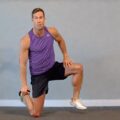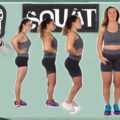The front squat is an effective compound exercise that works multiple muscle groups throughout the body, from your pelvic floor to your shoulders. Mastering the front squat can strengthen these muscles, enhancing your overall fitness and performance.
Why the front squat is so great for full-body strength
Unlike back squats where the barbell rests behind your shoulders, the front squat positions the barbell across the front of your shoulders. This challenges your posture, core strength, and shoulder mobility in unique ways. By mastering the front squat, you train your body how to properly stabilize and coordinate movement under load. This builds total body strength and resilience.
Proper front squat form from top to bottom
Here is a step-by-step breakdown for proper front squat form:
- Pelvic floor and core engaged: Activate your pelvic floor and brace your core. This provides stability and a strong foundation.
- Shoulders down and back: Roll your shoulders down and back to open up the front rack position.
- Elbows up high: Keep your elbows lifted high to support the barbell.
- Chest is upright: Maintain an upright chest as you begin the movement. Don’t lean forward excessively.
- Hip drive: Push your hips back then drive through your heels to power out of the squat. Keep your knees aligned over your toes.
Modify to avoid injury
To avoid injury while mastering the front squat:
- Use lighter weights or bodyweight until you have proper form.
- Place a yoga block or small plates under your heels to assist limited ankle mobility.
- Widen your stance if needed to find balance and stability.
The best front squat workout
Once you have practiced proper front squat form, incorporate it into your weekly training. Here is an effective full-body workout to master the front squat:
Warm Up
- Foam rolling: Spend 5 minutes foam rolling your legs, hips, back and shoulders. This improves mobility.
- Air squats: Do 1-2 sets of 12-15 bodyweight air squats.
Workout
- Front squats: 4 sets of 8-10 reps. Rest 1-2 minutes between sets.
- Split squats: 3 sets of 10-12 reps per side. Rest 1 minute between sets.
- Glute bridges: 3 sets of 12-15 reps. Rest 1 minute between sets.
- Planks: 3 sets of 30-60 seconds. Rest 30 seconds between sets.
Cooldown
- Child’s pose: Hold for 1-2 minutes.
- Calf and hamstring stretch: 30 seconds per leg.
Tips for mastering the front squat
Here are some helpful tips as you work to master front squat form:
- Start with just the barbell until you perfect form. Gradually increase weight.
- Record yourself and check your form. Make small tweaks as needed.
- Engage your lats and core before squatting. This provides stability.
- Breathe properly. Inhale as you lower down, exhale as you drive back up.
- Strengthen your upper back, core and glutes with accessory exercises like rows, planks and glute bridges.
FAQ
Is the front squat better than the back squat?
The front and back squat both have unique benefits. The front squat better targets your quads while challenging core stability and shoulder mobility. The back squat allows you to lift heavier loads overall. Both are great compound lifts worth including in your routine.
What muscles does the front squat work?
The front squat targets several muscle groups since it is a compound movement. Primary movers are the quads, glutes and hamstrings. It also heavily engages your core, upper back and shoulders for stabilization.
Should I squat with dumbbells or barbell?
Barbell front squats allow you to safely progress to heavier loads. But beginner or mobility-limited lifters may start with dumbbell front squats to get used to the movement pattern.
How deep should I squat?
Aim to squat just below parallel, meaning your hip crease sinks just below your knee caps. Squatting too deep can strain your low back. Squatting above parallel reduces quad involvement.
How wide or narrow should my stance be?
Your feet should be about shoulder-width apart or slightly wider. Play with your stance width to find what allows you to best sit into the movement while keeping your knees aligned over toes.









